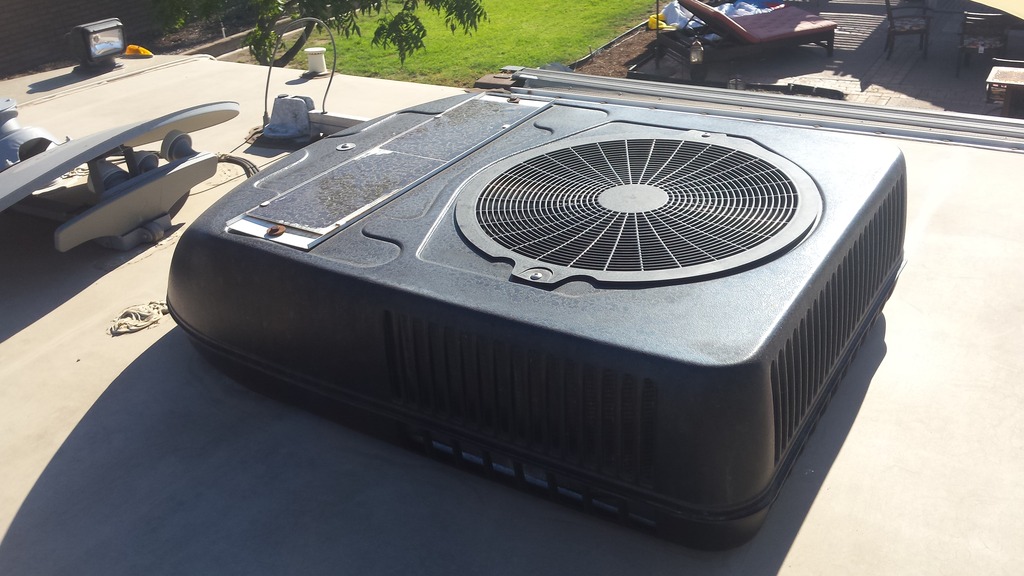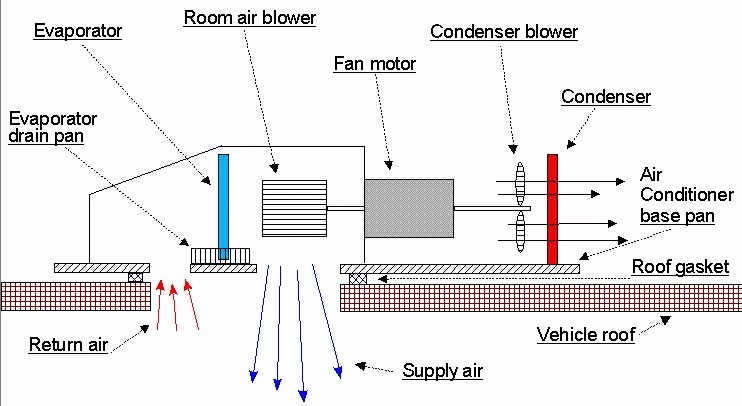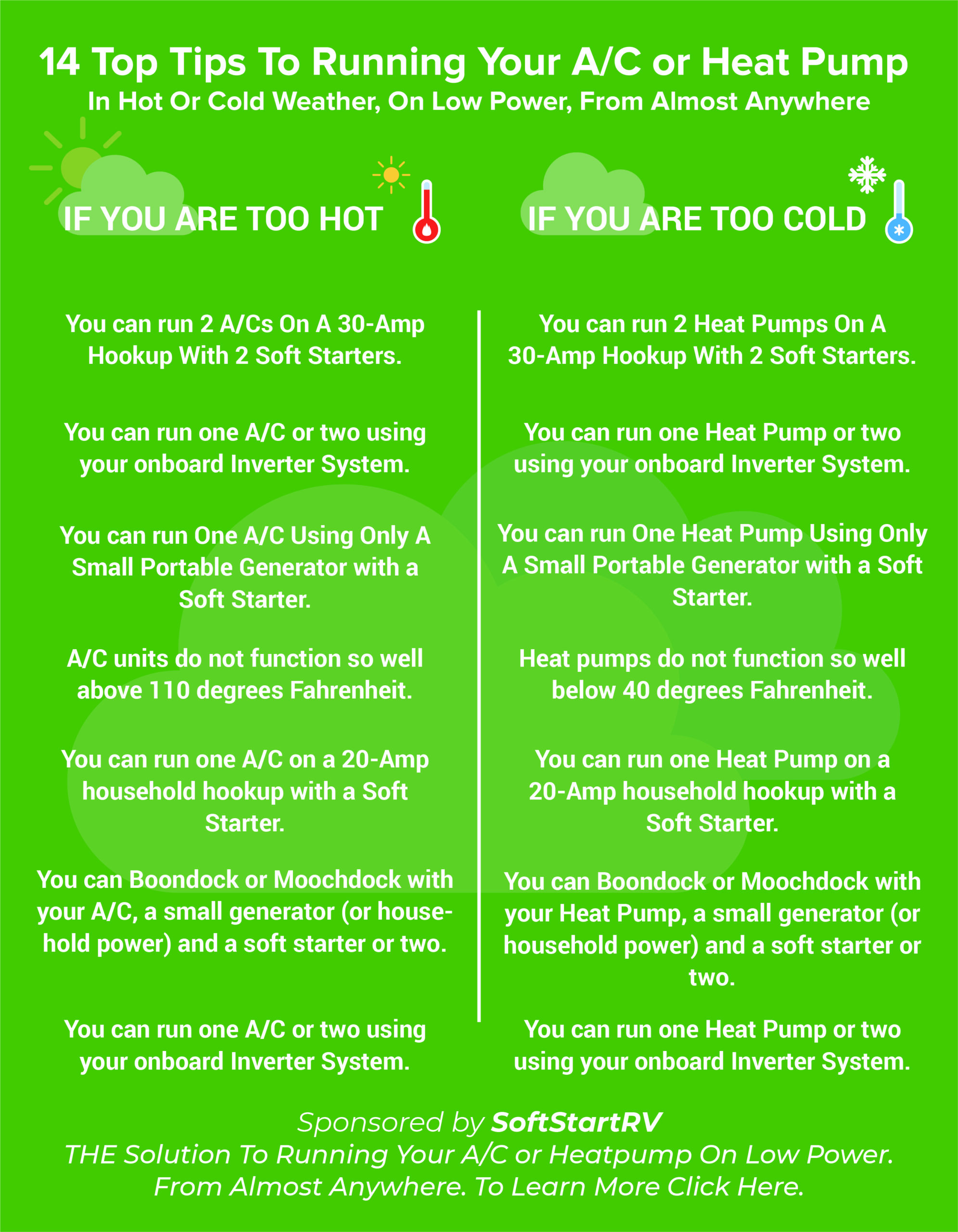Try This DIY RV Heat Pump Hack
By Levi Henley Camping, DIY, Gear, Mods

Try This DIY RV Heat Pump Hack
As summer starts coming to an end, the days get shorter. The leaves start changing color,and the air starts to get a little chill in it. Everything, including socks and oil changes, seems to be pumpkin spice flavored.
Not every camper puts their rig away for the year when the colder weather blows in. Many full-time RVers and weekend warriors alike know that the warm chocolatey-marshmallow center of a s’mores goes well with a cup of hot cocoa on a cold November night. As long as their RV heat pump is working.
RVing in Cold Weather
RVers have no problem camping in cool or cold weather because of their built-in RV heater systems. Most, if not all, have a propane furnace, and some RV air conditioning units also have an RV heat pump feature. If your RV has an electric heat setting on the thermostat, you are already fitted with an economical and energy-efficient RV heater.
Not all RVs come with an RV heat pump as part of the RV’s heater system. A/C units that have a heat pump option are pricier. Just how do these systems work? Are they worth it? Are there any drawbacks?
Turning an A/C into an RV heater 101
If you ever asked a technician or RV salesperson how an RV heat pump works, you will probably get a basic answer that goes something like, “It runs your air conditioner in reverse, so the RV cooler becomes an RV heater.” That answer is perfectly cool…or warm…whatever.
Though the answer is correct. It’s vague. If you are like me, you want to know exactly how it works. If you aren’t like me and are just happy that it works, I’m still going to tell you. I’m persistently geeky like that, to a fault, really.

The RV A/C unit
Before going into how an A/C turns into an RV heat pump, its best to start with how an A/C works in the first place. An RV air conditioner unit has six main parts that make it work: compressor, condenser, evaporator, refrigerant, and two fans to move air over the condenser and evaporator.
The Refrigerant
The refrigerant is a special liquid that turns to vapor at rather low temperatures. When a liquid turns into a gas, it absorbs heat.
Think about sweating. When it’s hot, your body covers you in liquid. If a warm breeze hits the liquid on your skin, a small amount of it will evaporate, and when it does, it takes some of your heat energy away from your skin. This causes your skin to cool. An air conditioner uses this principle to remove the heat from inside your RV and vent it outside the RV.
Evaporator
Low-pressure liquid gets pushed into the evaporator, which looks a lot like a car radiator with lots of metal fins. A fan pulls the warm air from your RV through and across the refrigerant filled coils of the evaporator. The refrigerant starts absorbing all the heat in the air being pulled across it. Since the heat has been pulled out of it, the air is cooler once it returns to your RV.
Absorbing the heat causes the liquid refrigerant to convert into a gas. The A/C unit has to vent off the heat it picked up from the air in your RV before it can turn the refrigerant gas back into a liquid to be used again.
Compressor
The next step on the refrigerant journey is the compressor. As the name suggests, it’s job is to compress the low-pressure gas coming from the evaporator and turn it into a high-pressure gas. Compressing the refrigerant causes it to heat up. The hot high-pressure refrigerant flows into the condenser.
Condenser
The condenser is a series of tubes and fins that look just like the evaporator. As the fan blows air through it, the gas cools and condenses into a liquid. In essence, the same type of device is being used on both ends of the air conditioner. One causes heat to be taken out of the air in your RV. The other blows that heat into the outside air.
After the refrigerant has condensed back into a liquid, it goes through a special part of piping that causes the pressure to drop. Taking the now-liquid refrigerant from a high-pressure state to a low-pressure one removes the heat added by the compressor.
At that point, the heat from your RV and the heat added by the compressor has been removed. The now cold liquid refrigerant flows into the evaporator once again to absorb some more heat from the air in your RV.
RV Heat Pump
Remember when I said the evaporator and the condenser are basically the same structure? What would happen if instead of absorbing heat from inside and blowing it outside, we reversed the flow of refrigerant so that it absorbed heat from outside and blew it inside?
That is exactly how the RV heat pump works. By using a valve called a reversing valve, the flow of refrigerant is altered so that the evaporator and the condenser basically switch places. By using a heat pump, you are literally taking the heat out of the outside air and transferring it into your RV.
If you are super interested in this kind of stuff, check out the video below. It explains exactly how the refrigerant flow is changed to make a heat pump work.
https://www.youtube.com/watch?v=QykwWs3L1W8
Using an RV Heat Pump as an RV Heater vs Propane Furnace
Cost
An RV heat pump is cheaper to run than a propane furnace. The average propane furnace in an RV uses about ⅓ of a gallon of propane every hour it runs. The average price of propane per gallon is between 2 and 3 dollars. So using propane as an RV heater can come out to 3 dollars every 3 hours of run time.
The largest RV heat pumps use about 1,200 watts of power once up and running. If you are staying long term, some campgrounds charge for electricity. The high end of that is usually not more than about 15 cents per kWh.
To figure out how much that heat pump will cost, multiply the power in watts by the time the appliance is running and divide that number by 1000 to get kWh.
- 1200 watts x 3 hours / 1000 = 3.6 kWh
- 3.6 kWh x 0.15 cents = $0.54
As you can see, the RV heat pump costs less than a dollar to run for three hours compared to the propane furnace. On top of that, if you are staying short term, most campgrounds do not charge you for electricity.
Even if you are boondocking and using a larger generator rated for RV air conditioners, you may find that it is cheaper to run your heat pump off your generator than it is to run the propane RV heater.
Outside Temperature
Heat pumps work very well until the temperature drops below the mid to high 30s (Fahrenheit). Once the temperature gets below that, there is not enough heat in the air to efficiently move to the inside of your RV. It is for this reason that RV heat pumps are best suited for climates that don’t regularly get below freezing.
A propane furnace works as an RV heater no matter the outside temperature. The ducting of many RV propane furnaces also heats up the compartments containing water pipes and tanks, preventing these areas from freezing too.
If you are in an area that gets below freezing at night and the daytime temps reach above 35 degrees regularly, you can save a lot of propane by running your heat pump during the day and running the propane at night.
Watts – The Problem
RV heat pumps take a lot of watts to run. Those who own 50 amp RVs know that not every park has 50 amp plugs, forcing customers to use 30 amps.
Many larger 50 amp rigs have two A/C/heat pump units. Having 30 amps is generally enough to run one RV A/C/heat pump unit but not two. If you want more information on the difference between 30 amp and 50 amp RVs and some tips on running your RV on 30 amps, check this article out on Camper Report.
For those who like to boondock, using the heat pump means you will have to carry a large generator that can run the heat pump. You don’t need a big generator if you only use the propane RV heater.
So if you are limited to 30 amps or a smaller generator, does that mean you are stuck with using propane only? If you have a large RV with two heat pumps, do you have to choose which heat pump to run? Is there a way to have your cake and eat it too? You know where this is going.
Get a SoftStartRV
A SoftStartRV device helps your RV air conditioner to start up with fewer watts, whether you are using it as an RV heater or an RV cooler. One of the main power draws from a heat pump unit is the compressor. When it turns on, it pulls all the power it needs to go from a standstill to full speed. This process is short, about 150 milliseconds, but it can be as high as 50 amps.
For a practical example, imagine you are trying to lift something heavy. You could summon all of your strength at once and lift it really fast. This would no doubt be hard on your body, and you would increase the risk of injury every time you did it. A safer method would be to lift it in a slower and controlled manner, ensuring that you don’t exert more energy than is necessary.
That is what a SoftStartRV does. It controls the voltage to slowly ramp up the compressor speed. The result is an air conditioner or heat pump that only requires about 25 amps to start up.
If you want to see this in action, Mike Sokol from RVelectricity has a great video. He recorded an A/C unit starting up with and without a SoftStartRV to show exactly how the unit helps.
SoftStartRV Helps Smaller Generators
If you like boondocking in the cooler months and prefer not to carry along extra propane tanks, a SoftStartRV can help you use your heat pump as your RV heater. Instead of having to get a larger 3000+ watt generator, you can run both your A/C and heat pump with a 2000 watt inverter generator.
That means your generator can be lighter and let’s face it, a few more gallons of gas is cheaper and easier than another propane bottle or two for an extended camping trip.
Run Both RV Heat Pumps
By installing a SoftStartRV on both of your A/Cs, with the heat pump function, you can run both of your units on a 30 amp socket. You don’t have to worry about which area of the RV to keep warm when the RV park only provides 30 amps.
Keep in mind that a SoftStartRV device can be used on each air conditioner to run both simultaneously on a 30 amp socket.
You Can DIY It
If you are like me, the thought of getting on your roof and messing with the wiring of your A/C is not a pleasant one. Well, I did it, and I am here to tell you that it was honestly pretty easy.
Had I not been filming the process for the review I wrote and to make the video of my install, it would have taken me about 30 minutes. The customer service department at SoftStartRV practically walked me through the process to boot.
Here is my installation and review video.
https://www.youtube.com/watch?v=vNmyS2f8lys
Conclusion
It’s not always easy when you are searching for the best RV heater. Propane furnaces work well but use up a lot of propane, which can be costly. You can plug in some of those small heaters you find at big box stores, but those are not necessarily safe around children and pets in small spaces.
If your air conditioner has a heat function, you have an economical, safe solution already at your fingertips as long as you are camping above freezing temps.
By installing a SoftStartRV on each of your units, you can ensure that you have the power to run your safe built-in RV heater no matter where you decide to camp.

To learn more, visit SoftStartRV’s website.




